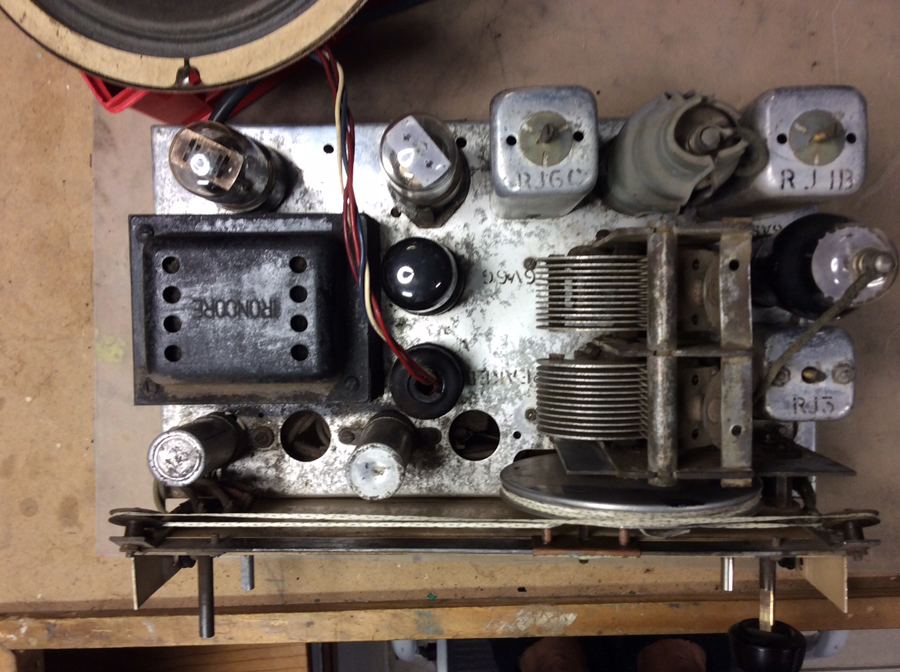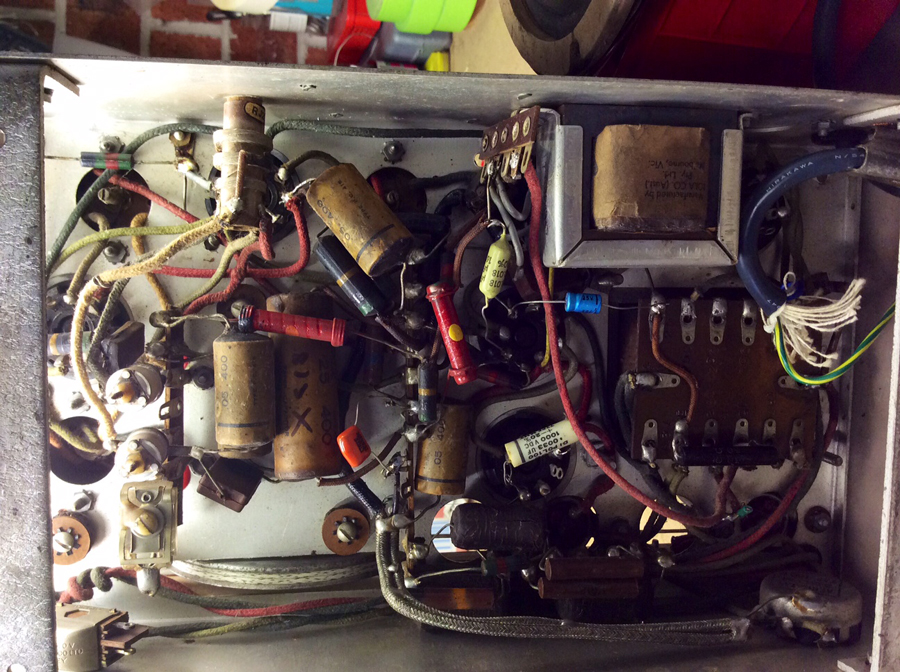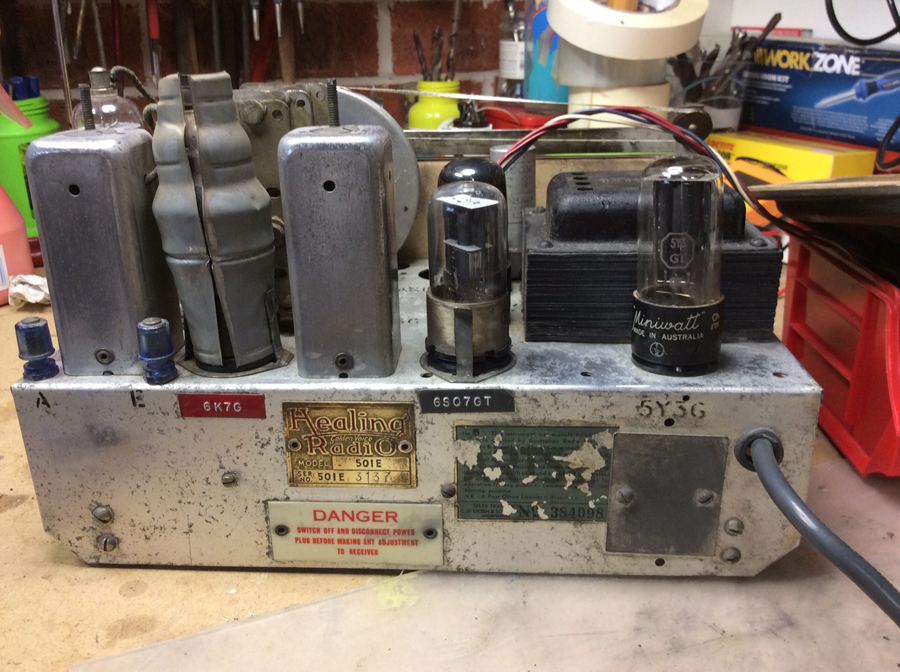Tech Talk
Forum home - Go back to Tech talk
|
Healing 501E Irregular Chassis?
|
|
|
« Back ·
1 ·
Next »
|
|
|
Return to top of page · Post #: 1 · Written at 10:56:54 AM on 4 May 2018.
|
|
|
|
Location: Sydney, NSW
Member since 22 May 2017 Member #: 2114 Postcount: 120 |
|
I have acquired at a recent the HRSA swap-meet what seems to be a nice and original Healing 501E, which I want to bring up to a safe and good working condition to run in my home office.    |
|
|
Return to top of page · Post #: 2 · Written at 2:24:10 PM on 4 May 2018.
|
|
|
|
Location: Belrose, NSW
Member since 31 December 2015 Member #: 1844 Postcount: 2637 |
|
Hey, if it works don't fix it! |
|
|
Return to top of page · Post #: 3 · Written at 4:32:37 PM on 4 May 2018.
|
|
|
|
Location: Hobart, TAS
Member since 31 July 2016 Member #: 1959 Postcount: 579 |
|
I also take replacing caps on a case by case basis, however over the 55 odd years of hobby and full time servicing. |
|
|
Return to top of page · Post #: 4 · Written at 7:39:17 AM on 5 May 2018.
|
|
|
|
Administrator
Location: Naremburn, NSW
Member since 15 November 2005 Member #: 1 Postcount: 7559 |
|
Photos uploaded. ‾‾‾‾‾‾‾‾‾‾‾‾‾‾‾‾‾‾‾‾‾‾‾‾‾‾‾‾‾‾‾‾‾‾‾‾‾‾‾‾‾‾‾‾‾‾‾‾‾‾‾‾‾‾‾‾‾‾‾‾‾‾‾‾‾‾‾‾ A valve a day keeps the transistor away... |
|
|
Return to top of page · Post #: 5 · Written at 9:57:25 AM on 5 May 2018.
|
|
|
|
Location: Belrose, NSW
Member since 31 December 2015 Member #: 1844 Postcount: 2637 |
|
Looks like previous owner has replaced the caps that matter with polyesters, The pitch-ended Ducon paper caps were better than the later "High Seal 85"s - they are probably OK. |
|
|
Return to top of page · Post #: 6 · Written at 11:06:34 AM on 5 May 2018.
|
|
|
|
Location: Sydney, NSW
Member since 22 May 2017 Member #: 2114 Postcount: 120 |
|
Thanks Ian, and Johnny for your input, I tend to follow the same principle for other things "if Ain't Brkoke,Don't mess with it". |
|
|
Return to top of page · Post #: 7 · Written at 12:41:37 PM on 5 May 2018.
|
|
|
|
Location: Belrose, NSW
Member since 31 December 2015 Member #: 1844 Postcount: 2637 |
|
Can electros are working OK? No hum? No sign of leakage, white crusty deposit around the terminals? |
|
|
Return to top of page · Post #: 8 · Written at 10:37:21 PM on 5 May 2018.
|
|
|
|
Location: Wangaratta, VIC
Member since 21 February 2009 Member #: 438 Postcount: 5602 |
|
Consensus on the American Forum and from what I see regularly, is that those Wax paper caps are a liability and can seriously impinge on the performance of a set and the welfare of the valves. In respect of "Non Polarised caps", I have one standard, as I have done quite a bit of commercial fixing. "If it leaks its a dud" |
|
|
Return to top of page · Post #: 9 · Written at 3:19:17 PM on 6 May 2018.
|
|
|
|
Location: Belrose, NSW
Member since 31 December 2015 Member #: 1844 Postcount: 2637 |
|
But the caps that are in a position that will damage anything if they leak have already been changed. |
|
|
Return to top of page · Post #: 10 · Written at 10:31:06 PM on 6 May 2018.
|
|
|
|
Location: Wangaratta, VIC
Member since 21 February 2009 Member #: 438 Postcount: 5602 |
|
You will note that was a general comment. In any radio fix I do, if I know the part is going to affect performance, be it resistor, or capacitor, leaving it there does not, in my book constitute a proper refurbish. In a commercial fix I am not getting payed to do half a job and failures are not good for business. |
|
|
Return to top of page · Post #: 11 · Written at 11:12:54 PM on 6 May 2018.
|
|
|
|
Location: Sydney, NSW
Member since 22 May 2017 Member #: 2114 Postcount: 120 |
|
Thank Ian and Marc both your comments make sense and understand this is a regular debating point on many sites and articles I have come across . |
|
|
« Back ·
1 ·
Next »
|
|
|
You need to be a member to post comments on this forum.
|
|

Sign In

Vintage Radio and Television is proudly brought to you by an era where things were built with pride and made to last.
DISCLAIMER: Valve radios and televisions contain voltages that can deliver lethal shocks. You should not attempt to work on a valve radio or other electrical appliances unless you know exactly what you are doing and have gained some experience with electronics and working around high voltages. The owner, administrators and staff of Vintage Radio & Television will accept no liability for any damage, injury or loss of life that comes as a result of your use or mis-use of information on this website. Please read our Safety Warning before using this website.
WARNING: Under no circumstances should you ever apply power to a vintage radio, television or other electrical appliance you have acquired without first having it checked and serviced by an experienced person. Also, at no time should any appliance be connected to an electricity supply if the power cord is damaged. If in doubt, do not apply power.
Shintara - Keepin' It Real · VileSilencer - Maintain The Rage
